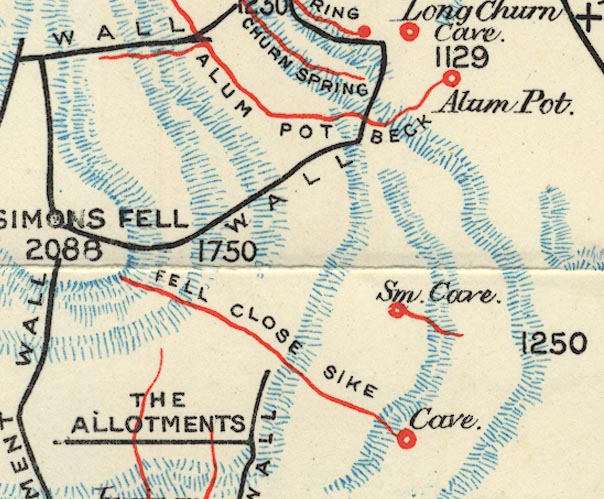




placename:- Long Churn
placename:- Dicken Pot
 goto source
goto sourceTour to the Caves in the West Riding of Yorkshire, late 18th century
Page 273:- "... we went a little higher up the mountain [from Alun Pot], and came to another hiatus, called Long-churn. We descended down till we came to a subterranean brook. We first ascended the cavern down which the stream ran, proceeding in a western direction for (at least as we imagined) a quarter of a mile, till we came to a crevice which admitted us into our native regions. We measured the distance between the two extremities above ground, and found it two hundred and forty-one yards; but it must be nearly double that distance along the passage below, on account of all the turnings and windings. The petrifactions here were the most numerous of any we had yet seen, few people coming either to break them off or deface them. When we were almost arrived at the western extremity, we came to a fine round bason of pellucid water, from three to twelve feet deep, known by the name of Dr. Bannister's Hand-bason. A lofty, spacious, and elegant"
 goto source
goto sourcePage 274:- "dome is placed immediately over it, which nicely corresponds to the hollow receptacle at the bottom. Into this bason a rivulet falls down a steep rock above six feet high, which is very dangerous to get up, and must be done at the expense of a wet skin, except a ladder is taken along with the party, or the waters are less copious than when we were there: there is also some danger lest the adventurer should fall back, and have his bones broken by circumjacent rocks, or be drowned in the doctor's bason. After having surmounted this obstacle, and proceeded some yards farther, we were favoured with an egress into our own element, as was before observed; no unwelcome change, after having been so long excluded from it. After having rested ourselves a little, we returned to the chasm where we first entered Long-churn, and descending again, pursued the rivulet eastward, along another extensive subterranean passage called Dicken-pot, which slopes and winds by degrees till it enters the ghastly and tremendous Alan-pot. We went an hundred and fifty-seven yards along this 'antre-vast,' till we came to a steep rock full twelve feet perpendicular. Here we stopped - a wise consideration. We might have descended perhaps without danger; but the question was, how were we to get up again; which, without ropes or a ladder, would be totally impracticable. At the far end was an elegant lofty dome, called by the country people St. Paul's. There is no doubt but if we had ventured further we might have come to Alan-pot, at least so near as either to have seen the water that stagnates at its bottom, or the light that is admitted into this gaping monster of nature."
placename:- Long Church
 goto source
goto sourcePage 202:- "LONG CHURN is a little further up the mountain to the right of Alum Pot. All the beautiful stalactites with which this cavern so much abounded, have been removed by cart loads to build artificial grottos."
placename:- Long Churn Cave
item:- stalactite
 goto source
goto sourcepage 53:- "..."
"Long Churn and Dicken Pot Caves."
"About one hundred yards north north-west of Alum Pot, is Long Churn Cave, and nearly a quarter-of-a-mile further is the upper mouth of Dicken Pot. Long Churn has years ago been robbed of the stalactites which it once so plentifully contained. It is a cave of engulfment, or one which has to be entered along with the stream that flows underground towards Alum Pot, and is of fair size. The passage in its earlier portion is by no means lofty."
"Dicken Pot is formed by a branch of the same stream in the higher part of its course, ..."
placename:- Long Churn Cave

BS1SD77S.jpg
"Long Churn Cave"
item:- private collection : 27.1
Image © see bottom of page
